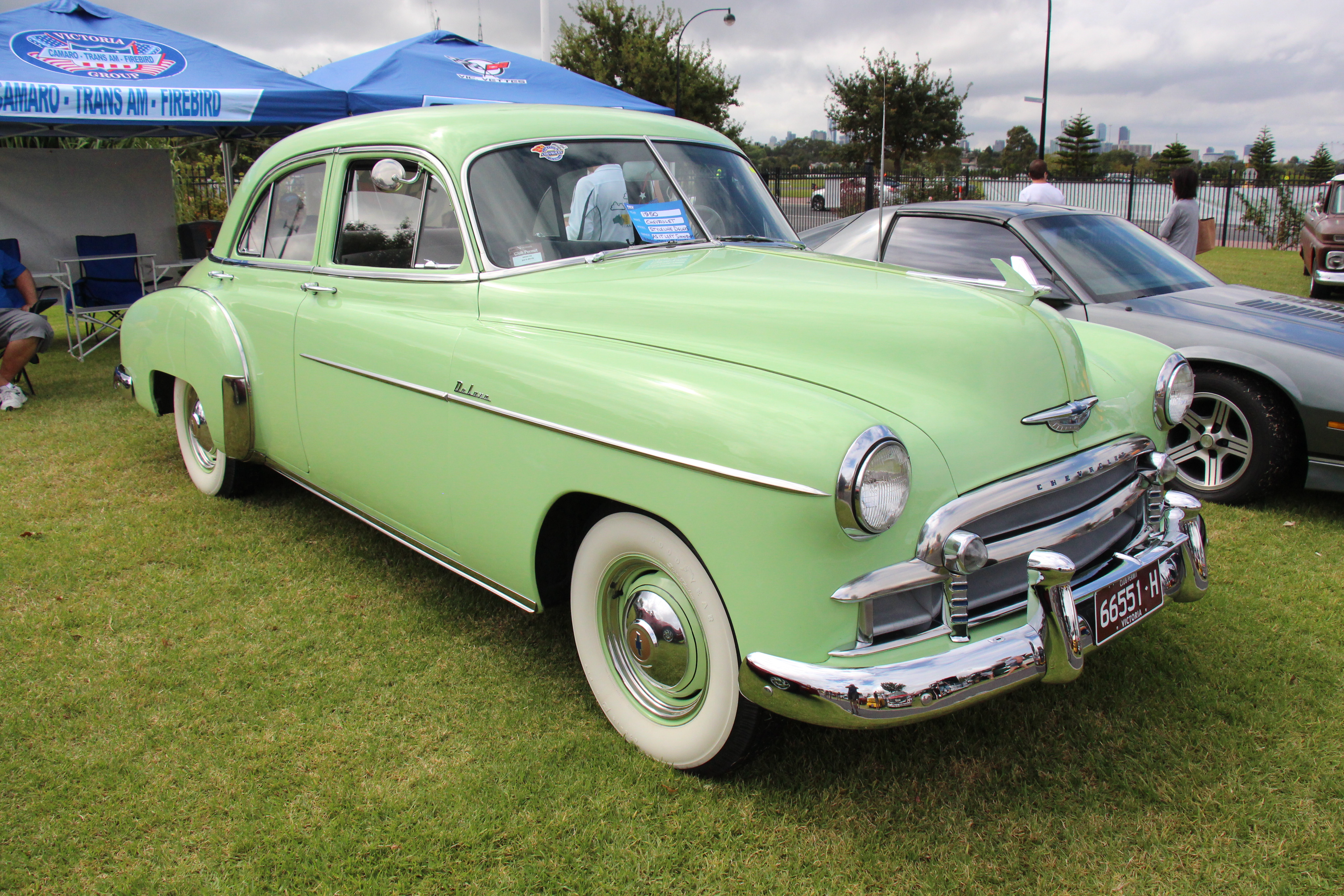
The 1950s automobile industry was a vibrant era filled with innovation and daring design choices that captivated car enthusiasts and everyday drivers alike, with the 1954 Chevrolet Corvair concept emerging as a remarkable chapter in this story. Initially showcased in the Motorama traveling exhibition, the Corvair concept aimed to revolutionize the compact car market in America, showcasing a fastback style that hinted at a bold new direction for Chevrolet’s future designs.
The Corvair’s design was revolutionary, as it strayed from conventional norms of the time. The hardtop fastback-styled roof not only provided an appealing aesthetic but also showcased Chevrolet’s willingness to embrace new engineering concepts. The vehicle was born out of the vision of Ed Cole, who was the chief engineer of the Chevrolet Motor Division and later became a key player in the overall development of the Chevrolet brand. His foresight positioned the Corvair as a response to the growing popularity of compact cars, particularly the Volkswagen Beetle, which was making waves in the American market.
Corvair’s engineering underpinnings
Delving into the engineering behind the Corvair shows a true dedication to pioneering innovation; while most American cars of the time sported front-engine layouts, the Corvair’s rear-engine design offered not only a distinctive driving experience but also enhanced interior space. With its air-cooled flat-six engine, a notable shift from Chevrolet’s standard engines, the Corvair was crafted to be lightweight and efficient, employing aluminum components to support growing consumer demands for better fuel efficiency.

Another major advancement was the incorporation of independent suspension on all four wheels. This design choice enhanced ride quality and handling, making the Corvair a more appealing option for drivers who valued performance. The independent suspension system was a feature that would later be adopted by many other manufacturers, exemplifying Chevrolet’s role in pushing the automotive envelope.
The Corvair concept car’s introduction garnered considerable attention, with audiences and critics alike praising its fresh engineering and design. Time magazine even featured the vehicle on its cover, celebrating the Corvair as a beacon of innovation in the automotive landscape. The excitement surrounding the concept eventually led to the production of the first-generation Corvair, which was rolled out in 1960 and continued to evolve through 1969.
The first-generation Corvair was initially offered in a range of body styles, including a 4-door sedan, a 2-door coupe, and a convertible, among others. This versatility allowed Chevrolet to capture a broad spectrum of the market, appealing to families, young professionals, and performance enthusiasts alike. With approximately 1.8 million units produced over its decade-long run, the Corvair demonstrated that there was substantial consumer interest in compact cars that combined innovative engineering with style.

Legacy is intertwined with controversy
However, the Corvair’s legacy is also intertwined with controversy. Ralph Nader’s book, “Unsafe at Any Speed,” famously criticized the vehicle, highlighting safety concerns regarding its handling. Although these criticisms were later tempered by studies showing that the Corvair’s handling was comparable to other contemporary compacts, the narrative surrounding the car had already taken hold, impacting its reputation. This dichotomy—between innovative engineering and safety concerns—fuels the ongoing debates among car enthusiasts and collectors today.
Despite various challenges throughout its journey, the Corvair has nurtured a passionate community of collectors and enthusiasts who recognize its groundbreaking role in the compact car segment, celebrating its inventive engineering as a testament to automotive creativity. The legacy of the Corvair extends beyond its striking design and performance, as it symbolizes American ingenuity and boldness in addressing consumer needs and expectations.
In reflecting on the 1954 Chevrolet Corvair concept, we must admire its ambitious goals alongside the obstacles it faced; its innovative essence and design principles not only influenced future Chevrolet models but also transformed compact cars throughout the automotive landscape. This remarkable vehicle is a vital chapter in America’s automotive history, captivating car lovers and industry insiders across generations.

As we explore the Chevrolet Corvair’s legacy, it’s hard not to be impressed by how this compact car made significant waves in the automotive world since its launch in the early 1960s. Hailed as a revolutionary vehicle, the Corvair not only introduced Americans to an exciting new era of compact cars, but it also ignited passionate debates that would resonate for decades, as its design and engineering innovations challenged traditional norms, while safety controversies have continued to influence discussions on automotive design and consumer protection.
The impact of the Corvair extends beyond its initial sales figures and engineering feats. The vehicle was a response to the growing demand for smaller, more efficient cars in the United States, a trend initially spearheaded by the European Volkswagen Beetle. Chevrolet understood this shift and strategically positioned the Corvair to cater to a diverse audience. The Corvair’s versatility was evident in its various body styles, including sedans, coupes, convertibles, and even station wagons. This adaptability allowed the Corvair to appeal to a wide range of customers—from families looking for practicality to young professionals seeking a stylish and economical ride.
Production numbers reflect the Corvair’s initial success. With around 1.8 million units produced from 1960 to 1969, the Corvair became one of Chevrolet’s best-selling models. Its sales peaked in the early 1960s, as consumers were drawn to its unique rear-engine layout and fuel efficiency. The Corvair offered something different in a market saturated with traditional front-engine vehicles. Enthusiasts often refer to the Corvair as a “poor man’s Porsche,” praising its spirited performance and engaging driving dynamics that set it apart from competitors.

However, the 1960s were a time of rapid change, and the Corvair faced fierce competition not only from within the American automotive industry but also from imports. The arrival of the Ford Mustang in 1964 introduced a new segment of sporty coupes that drew attention away from the Corvair. This shift in consumer preferences was challenging for the model, as it struggled to maintain its relevance in an evolving market. As the decade progressed, the Corvair’s sales began to wane, and Chevrolet was forced to adapt its strategies accordingly.
One of the major turning points in the Corvair’s legacy came with Ralph Nader’s book “Unsafe at Any Speed,” published in 1965. Nader’s critique focused on the Corvair’s handling and safety features, effectively igniting a firestorm of controversy. While subsequent studies, including a 1972 report by Texas A&M, showed that the Corvair’s handling was comparable to other compact cars of the era, the damage to its reputation had already been done. The narrative of the Corvair as an unsafe vehicle lingered, influencing public perception and sales for years.
A resurgence in interest and appreciation
Amid the controversies, the Corvair developed a passionate following. Collectors and enthusiasts alike celebrate the car for its unique engineering and design. The Corvair’s air-cooled engine and rear-engine layout have become highlights of its identity, often capturing the hearts of those who appreciate its distinctiveness. Today, vintage Corvairs can fetch impressive prices at auctions, indicating a resurgence in interest and appreciation for this pioneering vehicle.

The Corvair’s influence reaches far into the future of automotive innovation, laying foundational engineering principles that inspired subsequent compact car designs. Many of its advanced features, including the unique suspension system, rear-engine layout, and the clever use of lightweight materials, were ahead of their time, inspiring countless generations of automotive engineers to push the boundaries of design.
As we reflect on the journey of the Chevrolet Corvair through the decades, it’s clear that its impact is multifaceted. From its innovative engineering and design to its polarizing reputation and eventual cult status, the Corvair serves as a testament to the complexities of the automotive industry. It embodies the spirit of innovation and the challenges of consumer perception, making it a significant chapter in American automotive history.
In the grand scheme of automotive design and consumer expectations, the Corvair represents a microcosm of the struggles and triumphs faced by manufacturers in an ever-evolving landscape. Its story is one of ambition, creativity, and resilience—a narrative that continues to resonate with car enthusiasts and collectors around the globe. The legacy of the Chevrolet Corvair is not merely a reflection of its time, but a lasting influence that continues to inspire automotive innovation and passion.

Looking ahead, the Corvair remains an intriguing focus for both automotive historians and enthusiasts who seek to learn from its rich history; the lessons gleaned emphasize the importance of safety, innovation, and consumer engagement in the automotive sector. The Corvair’s legacy is a potent reminder that even as vehicles evolve, the driving force of innovation and the pursuit of excellent design will always thrive, marking the 1954 Chevrolet Corvair concept as a pivotal milestone that has forever altered the compact car segment and the automotive industry as a whole.
Related posts:
Chevrolet Corvair
1954 Corvette Corvair: The Coolest Car That No Longer Exists!
Corvettes for Sale: 1954 Corvette Corvair Motorama Recreation Offered at Auction



